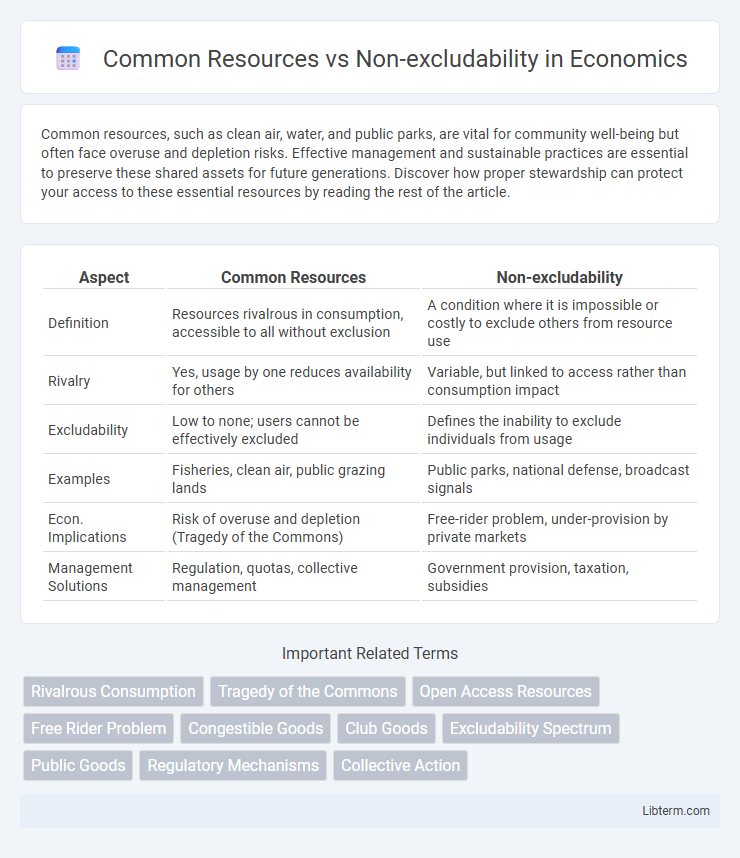Common resources, such as clean air, water, and public parks, are vital for community well-being but often face overuse and depletion risks. Effective management and sustainable practices are essential to preserve these shared assets for future generations. Discover how proper stewardship can protect your access to these essential resources by reading the rest of the article.
Table of Comparison
| Aspect | Common Resources | Non-excludability |
|---|---|---|
| Definition | Resources rivalrous in consumption, accessible to all without exclusion | A condition where it is impossible or costly to exclude others from resource use |
| Rivalry | Yes, usage by one reduces availability for others | Variable, but linked to access rather than consumption impact |
| Excludability | Low to none; users cannot be effectively excluded | Defines the inability to exclude individuals from usage |
| Examples | Fisheries, clean air, public grazing lands | Public parks, national defense, broadcast signals |
| Econ. Implications | Risk of overuse and depletion (Tragedy of the Commons) | Free-rider problem, under-provision by private markets |
| Management Solutions | Regulation, quotas, collective management | Government provision, taxation, subsidies |
Understanding Common Resources: Definition and Examples
Common resources are natural or man-made assets that are accessible to all members of a community but are rivalrous, meaning their use by one person diminishes availability for others. Examples include fisheries, groundwater basins, and public grazing lands, which are non-excludable but susceptible to overuse or depletion. Understanding common resources is critical for managing shared environments and addressing challenges such as the tragedy of the commons and sustainable resource allocation.
The Concept of Non-excludability Explained
Non-excludability refers to a characteristic of common resources where individuals cannot be effectively prevented from accessing or using them, regardless of payment or ownership rights. This trait often leads to challenges such as overconsumption or the "tragedy of the commons," where the resource is depleted due to unrestricted access. Understanding non-excludability is crucial for managing common resources like fisheries, public parks, and clean air to ensure sustainable usage and prevent resource depletion.
Key Differences: Common Resources vs. Non-excludable Goods
Common resources are rivalrous and non-excludable, meaning their use by one individual reduces availability for others, but exclusion from use is difficult. Non-excludable goods, also known as public goods, are non-rivalrous with affordable access for all individuals without reducing availability. The key difference lies in rivalry: common resources are rivalrous, causing potential depletion, whereas non-excludable goods remain available regardless of individual consumption.
Characteristics of Common Resources
Common resources are characterized by their rivalrous consumption, meaning one person's use reduces availability for others, but they lack excludability, preventing effective restriction of access. These resources often lead to overuse or depletion due to their open-access nature, exemplified by fisheries, forests, and clean air. Effective management typically requires collective action or regulatory measures to ensure sustainability and prevent the tragedy of the commons.
Non-excludability in Public Goods and Common Resources
Non-excludability refers to the characteristic where individuals cannot be prevented from accessing a good once it is provided, a fundamental trait of public goods and common resources. Public goods, such as national defense or clean air, are both non-excludable and non-rivalrous, meaning one person's use does not reduce availability for others. Common resources like fisheries or groundwater are non-excludable yet rivalrous, leading to potential overuse and depletion without effective management.
The Tragedy of the Commons: Causes and Implications
The Tragedy of the Commons occurs when common resources, such as fisheries or grazing lands, are overexploited due to non-excludability, where no individual can be effectively prevented from using the resource. This lack of exclusion leads to overconsumption, depletion, and eventual degradation of the resource, jeopardizing its sustainability. Understanding the causes, including free-rider problems and collective action failures, is critical for developing effective management strategies to mitigate environmental and economic impacts.
Management Challenges with Non-excludable Resources
Non-excludable common resources present significant management challenges due to their susceptibility to overuse and depletion, as individuals cannot be effectively prevented from accessing or exploiting them. This leads to the "tragedy of the commons," where lack of exclusion results in resource degradation, requiring collective action or regulatory mechanisms to ensure sustainable use. Effective management often involves implementing quotas, community-based monitoring, or government intervention to balance access rights with conservation efforts.
Real-world Examples of Non-excludability in Common Resources
Fisheries and public pastures illustrate non-excludability in common resources, where no individual can easily prevent others from accessing fish stocks or grazing land. This lack of exclusion often leads to overuse and depletion, exemplifying the "tragedy of the commons" phenomenon. Effective management strategies, such as community quotas or regulated access, are essential to sustain these non-excludable resources.
Solutions for Conserving Common Resources
Common resources, characterized by non-excludability and rivalrous consumption, face overuse risks that demand sustainable management. Implementing defined property rights, community-based resource management, and regulatory policies such as quotas and permits effectively curb overexploitation. Technological advancements in monitoring and enforcement further enhance conservation by ensuring compliance and promoting efficient resource utilization.
Policy Approaches: Regulating Non-excludable Resources
Policy approaches to regulating non-excludable common resources often involve implementing collective management strategies, such as community-based governance and co-management frameworks, to prevent overuse and depletion. Regulatory mechanisms include establishing usage quotas, licensing systems, and monitoring programs that promote sustainable resource allocation while addressing free-rider problems inherent in non-excludability. Economic incentives, like tradable permits or congestion pricing, complement regulatory efforts by internalizing externalities and encouraging responsible consumption behavior.
Common Resources Infographic

 libterm.com
libterm.com